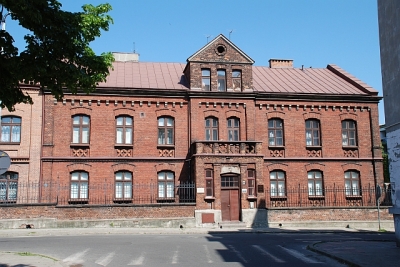During the war, the parish house of the St.Mary's Assumption’s Church was the location of the police criminal unit, the so-called Kripo. The inhabitants of the ghetto called that particular police station "The Red House" ("Rote Haus"), in reference to the brick color and what it represented, a place of torture.
 The German Kripo post was appointed on May 19, 1940, and it went by the name of the "Sonderkommando Getto". From 1942, it was called the "Kriminalkommissariat Getto.” Initially, the Kripo was to fight smuggling and to watch that no one entered or left the ghetto without permission. However, detecting and confiscating property hidden by the ghetto inhabitants gradually became its main task. Within only four months, from the end ofJune until the end of October in 1942, the Nazis confiscated belongings worth 586,000 German marks. These possessions included jewellery, foreign currency, glassware, fur coats, carpets and tapestries.
The German Kripo post was appointed on May 19, 1940, and it went by the name of the "Sonderkommando Getto". From 1942, it was called the "Kriminalkommissariat Getto.” Initially, the Kripo was to fight smuggling and to watch that no one entered or left the ghetto without permission. However, detecting and confiscating property hidden by the ghetto inhabitants gradually became its main task. Within only four months, from the end ofJune until the end of October in 1942, the Nazis confiscated belongings worth 586,000 German marks. These possessions included jewellery, foreign currency, glassware, fur coats, carpets and tapestries.
On average, the Kripo employed approximately 20 officers, many of whom were Lodz Germans who spoke Polish and Yiddish. The Kripo also had a network of Jewish informers that provided information on who might have hidden valuables. A Jewish police unit, which guarded the jail, was housed on the ground floor. There was one isolated cell that held one person, and six other cells.
The Kripo had the authority to carry out searches at any time, day or night. They routinely beat and tortured their victims to get people to talk. In the ghetto, "The Red House" was tantamount to a torture chamber. Upon entering, a person was typically left dead or disabled. More often than not, the family would receive information about the sudden death of an arrestee. In 1943, the Kripo was structurally connected to the Gestapo and started to prosecute political offences as well. This police station operated in the ghetto until the end of the war.
After the war, the building was returned to the Assumption Church.
The Gestapo is cracking down hard on the Jews in the ghetto. Today all "newsers", i.e. those who listened to the radio and spread political news in the ghetto, were arrested. Already about 40 people are doing time. Allegedly the Gestapo and the Kripo (Kriminalpolizei) have employed a lot of new Jewish snoopers recently. One must really beware of them.
Dawid Sierakowiak, Saturday, June 21, 1941.
The Kripo's duty was to confiscate everything. But before they did it, they had to find out if something is hidden somewhere, and where it is hidden. There was only one practically foolproof method here. The suspect having hidden something valuable was arrested, and then beaten and tortured long enough to plead guilty, i. e. to say what and where it is hidden. For when he had nothing left, if he had not hidden anything, if he had not given a golden wedding ring, a fur coat or a piece of woollen cloth to someone for safekeeping - there was no way for the suspect to get out of the Kripo station alive.
Arnold Mostowicz, The Yellow Star and the Red Cross, p. 23.
On the same day, without any delay, in the courtyard of the camp a car arrived. Stepping out of the car was Schwind and Neuman, the Kripo commander, wearing an SS uniform. After Schwind's" introduction," Neuman gave a short speech. He accused us of not working properly and of robbing the ghetto's property, which belongs to the German authorities. Then Brauder stepped out and called out the names of two people, and claimed to have found the "stolen" goods in their possession. Subsequently, Danciger mentioned by name four Jews who sabotaged the work. Neuman ordered all the "negligent" six to step out and handed them over to the Kripo agents. Our wretched companions were executed in the late evening hours.
Jakub Poznanski, Diary from the Lodz Ghetto, January 12, 1945, p. 261.

 Home
Home
